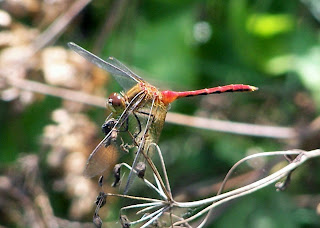DRAGONFLIES OF SOUTHEASTERN MINNESOTA
NATURE NOTES
NATURE NOTES OF S.E. MINNESOTA
Monday, July 2, 2012
What a beautiful dragonfly. He cooperated by letting me get right below him and shoot toward the sky. This is a Twelve-spotted Skimmer (male). Just in the last year we have become interested in dragonflies and have found a whole new world! We have posted pictures of the dragonflies we have seen in the last two months in Southeastern Minnesota. We had no idea they were so beautiful and so varied. What we took for granted for years, has become a revelation.
This dragonfly is called a Midland Clubtail. Look at the thorax (tail section) Notice that the last section is enlarged like a club, thus the name. There are many species in the Clubtail family. Many of them tend to be yellow, black, and often green in color.
TO SEE MORE PHOTOS OF DRAGONFLIES GO UP AND TO THE RIGHT. CLICK ON JULY 2012.
Green Darners are large dragonflies that will range far from water and even migrate. Pictured above is a juvenile Green Darner that is close to adulthood. (the adult male will have a bluish tail section) Even though our home is about half a mile from water, our prairie has many Green Darners. We appreciate all our dragonflies because they help to control our insect pests. ( the famous Minnesota mosquitos)
The Ebony Jewelwing male appears at times to be purple and at times green as the sunlight plays on its body. The Jewelwings are actually damselflies and not dragonflies. The damselflies tend to hold their wings upright, their bodies are more delicate, and they have a somewhat different eye structure than dragonflies.
undersidea.JPG)
2.JPG)


LLand+home.JPG)
---.JPG)

.jpg)
+home.JPG)
.JPG)





bgreat.JPG)
g1.jpg)
